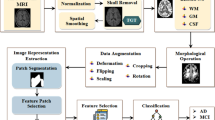Abstract
Double inversion-recovery (DIR) imaging has the potential to improve the detection of subcortical lesions through the use of voxel-based morphometry (VBM) analysis. The aim of this study was to clarify the characteristics of detectable lesions by performing a VBM analysis on DIR images of simulated lesions. Twenty healthy volunteers underwent magnetic resonance imaging using a head three-dimensional DIR sequence. The images were processed using SPM12; then, the selected images with simulated lesions were analyzed via VBM. The VBM results were evaluated using free-response receiver-operating characteristic curves and a receiver-operating characteristic analysis. The sensitivity was 100% (5/5), with 5.6 false-positive objects per case, in simulated lesions with a contrast of 0.6 and a size of 2.4 mm. The sensitivity was 80% (4/5), with 5.4 false-positive objects per case, in simulated lesions with a contrast of 0.5 and a size of 2.4 mm. The mean area under the curve value was increased from 0.783 to 0.883 using VBM, with a statistically significant difference (p < 0.01). The VBM analysis of the DIR images using SPM alone showed the potential to detect subcortical microscopic lesions. Early detection of Alzheimer’s disease may be possible by adapting VBM in the clinical setting.







Similar content being viewed by others
References
Brundel M, de Bresser J, van Dillen JJ, Kappelle LJ, Biessels GJ. Cerebral microinfarcts: a systematic review of neuropathological studies. J Cereb Blood Flow Metab. 2012;32(3):425–36.
Ii Y, Maeda M, Kida H, Matsuo K, Shindo A, Taniguchi A, et al. In vivo detection of cortical microinfarcts on ultrahigh-field MRI. J Neuroimaging. 2013;23(1):28–32.
Boulby PA, Symms MR, Barker GJ. Optimized interleaved whole-brain 3D double inversion recovery (DIR) sequence for imaging the neocortex. Magn Reson Med. 2004;51(6):1181–6.
Chen Z, Li L, Sun J, Ma L. Mapping the brain in type II diabetes: voxel-based morphometry using DARTEL. Eur J Radiol. 2012;81(8):1870–6.
Matsuda H, Mizumura S, Nemoto K, Yamashita F, Imabayashi E, Sato N, et al. Automatic voxel-based morphometry of structural MRI by SPM8 plus diffeomorphic anatomic registration through exponentiated lie algebra improves the diagnosis of probable Alzheimer disease. Am J Neuroradiol. 2012;33(6):1109–14.
Schmidt P, Gaser C, Arsic M, Buck D, Forschler A, Berthele A, et al. An automated tool for detection of FLAIR-hyperintense white-matter lesions in multiple sclerosis. Neuroimage. 2012;59(4):3774–83.
Shigemoto Y, Matsuda H, Kamiya K, Maikusa N, Nakata Y, Ito K, et al. In vivo evaluation of gray and white matter volume loss in the parkinsonian variant of multiple system atrophy using SPM8 plus DARTEL for VBM. Neuroimage Clin. 2013;2:491–6.
Spies L, Tewes A, Suppa P, Opfer R, Buchert R, Winkler G, et al. Fully automatic detection of deep white matter T1 hypointense lesions in multiple sclerosis. Phys Med Biol. 2013;7;58(23):8323–37.
Takahashi N, Tsai DY, Lee Y, Kinoshita T, Ishii K. Z-score mapping method for extracting hypoattenuation areas of hyperacute stroke in unenhanced CT. Acad Radiol. 2010;17(1):84–92.
Nakatsuka T, Imabayashi E, Matsuda H, Sakakibara R, Inaoka T, Terada H. Discrimination of dementia with Lewy bodies from Alzheimer’s disease using voxel-based morphometry of white matter by statistical parametric mapping 8 plus diffeomorphic anatomic registration through exponentiated Lie algebra. Neuroradiology. 2013;55(5):559–66.
Klein A, Andersson J, Ardekani BA, Ashburner J, Avants B, Chiang MC, et al. Evaluation of 14 nonlinear deformation algorithms applied to human brain MRI registration. Neuroimage. 2009;46(3)(1):786–802.
van Dalen JW, Scuric EE, van Veluw SJ, Caan MW, Nederveen AJ, Biessels GJ, et al. Cortical microinfarcts detected in vivo on 3 T MRI: clinical and radiological correlates. Stroke. 2015;46(1):255–7.
Simon B, Schmidt S, Lukas C, Gieseke J, Traber F, Knol DL, et al. Improved in vivo detection of cortical lesions in multiple sclerosis using double inversion recovery MR imaging at 3 T. Eur Radiol. 2010;20(7):1675–83.
Author information
Authors and Affiliations
Corresponding author
Ethics declarations
Conflict of interest
The authors declare that they no conflicts of interest.
Statement of human rights
All procedures performed in studies involving human participants were in accordance with the ethical standards of the institutional research committee and with the 1964 Helsinki Declaration and its later amendments or comparable ethical standards.
Statements of animal rights
This article does not contain any animal studies performed by any of the authors.
Informed consent
Informed consent was obtained from all individual participants included in this study.
Additional information
Publisher’s Note
Springer Nature remains neutral with regard to jurisdictional claims in published maps and institutional affiliations.
About this article
Cite this article
Yusuke, S., Norio, H., Tomoko, M. et al. Voxel-based morphometry analysis of double inversion-recovery magnetic resonance imaging for detecting microscopic lesions: a simulation study. Radiol Phys Technol 12, 149–155 (2019). https://doi.org/10.1007/s12194-019-00501-1
Received:
Revised:
Accepted:
Published:
Issue Date:
DOI: https://doi.org/10.1007/s12194-019-00501-1




